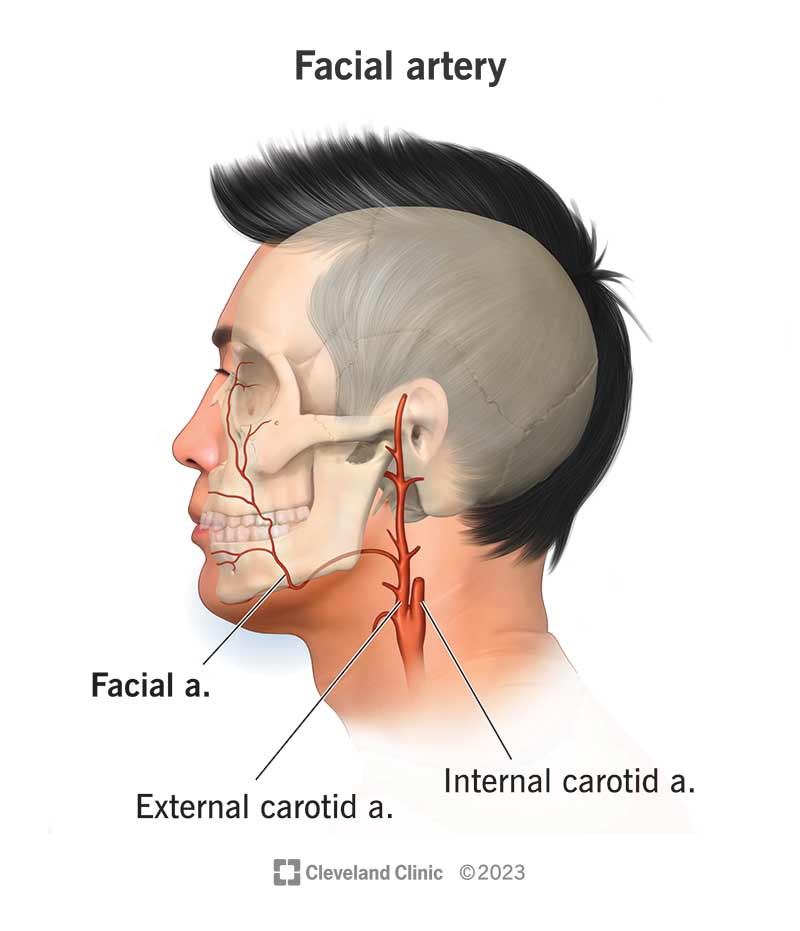Your facial artery brings blood from your neck to the lower parts of your face, like your mouth and cheeks. Your facial artery has several branches in your neck and face. Healthcare providers who inject cosmetic fillers need to be aware of this artery to avoid damaging it.
Advertisement
Cleveland Clinic is a non-profit academic medical center. Advertising on our site helps support our mission. We do not endorse non-Cleveland Clinic products or services. Policy

Your facial artery is an artery that runs through a large part of your neck and face. You have one facial artery on each side of your face, ending on either side of your nose and mouth.
Advertisement
Cleveland Clinic is a non-profit academic medical center. Advertising on our site helps support our mission. We do not endorse non-Cleveland Clinic products or services. Policy
Healthcare providers used to call this artery your external maxillary artery.
Your facial artery supplies blood to the parts of your face that are closer to the surface. These include:
If a surgeon removes a tumor from your head or neck, they may rely on your facial artery to supply blood to the areas they reconstruct.
Your facial artery starts in the side of your neck and runs diagonally across your cheek. It ends just below your eye. On the way from your neck to your cheek, your facial artery crosses over your jawbone.
Your facial artery branches off from your external carotid artery, which runs up and down the side of your neck. If you don’t have an external carotid artery, your facial artery may branch off of your internal or common carotid artery. It also might come from the same base as your lingual artery instead of having its own separate starting point.
Facial artery anatomy includes branches that start from two different parts of the facial artery.
Branches of the facial artery in your neck are the:
Facial artery branches in your face are the:
Advertisement
Your facial artery has twists that allow it to stretch while you’re chewing or moving your mouth in other ways. Some people have facial arteries that are larger than normal or didn’t develop completely.
All of your arteries, including your facial artery, have a hollow space inside their tubelike structure. Your blood goes through this hollow space. Arteries have three layers, including muscles that adjust the size of the hollow space inside.
Conditions that can affect your facial artery include:
Symptoms of facial artery conditions include:
If you have a stroke or transient ischemic attack (TIA), you have atherosclerosis in your carotid artery (which sends blood to your facial artery).
Healthcare providers can use imaging to see your facial artery in a noninvasive way. They may use:
They also may do blood tests.
Treatments for conditions that affect your facial artery may include:
You can take care of your facial artery the same way you care for your other blood vessels. You can:
When you move your mouth and cheeks, you’re probably not thinking about the blood supply that lets your face’s muscles work. But your facial arteries make sure the lower part of your face has the oxygen it needs. Regular checkups with your provider can help you keep all of your arteries healthy.
Advertisement
When your heart needs some help, the cardiology experts at Cleveland Clinic are here for you. We diagnose and treat the full spectrum of cardiovascular diseases.

Last reviewed on 05/16/2023.
Learn more about the Health Library and our editorial process.